Python 官方文档:入门教程 => 点击学习
目录一、五种模式详解1.简单模式(Queue模式)2.争抢模式(Work模式)3.路由模式(Route模式 Direct定向)4.发布订阅模式(Pulish/Subscribe模式
当生产端发送消息到交换机,交换机根据消息属性发送到队列,消费者监听绑定队列实现消息的接收和消费逻辑编写.简单模式下,强调的一个队列queue只被一个消费者监听消费.
1.1 结构

生产者:生成消息,发送到交换机交换机:根据消息属性,将消息发送给队列消费者:监听这个队列,发现消息后,获取消息执行消费逻辑
1.2应用场景
常见的应用场景就是一发,一接的结构
例如:
手机短信邮件单发
强调的也是后端队列与消费者绑定的结构
2.1结构
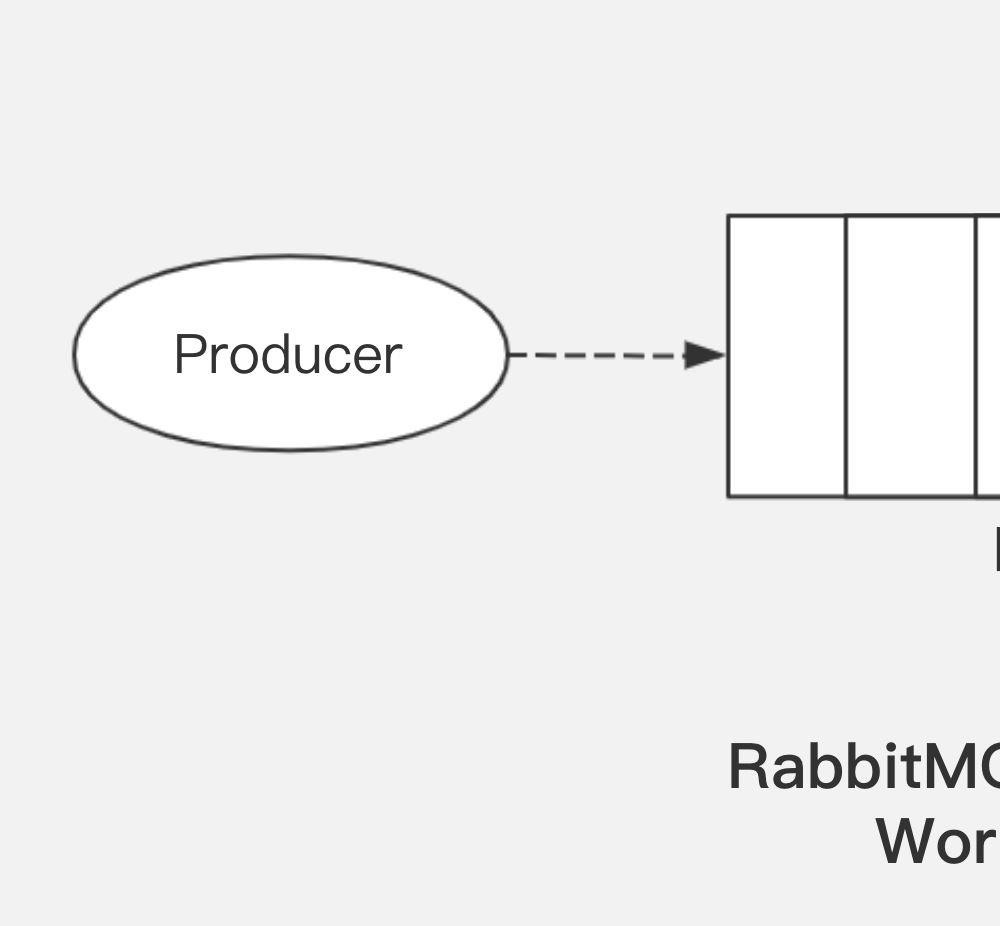
生产者:发送消息到交换机交换机:根据消息属性将消息发送给队列消费者:多个消费者,同时绑定监听一个队列,之间形成了争抢消息的效果
2.2应用场景
从路由模式开始,关心的就是消息如何到达的队列,路由模式需要使用的交换机类型就是路由交换机(direct)
3.1 结构

3.2应用场景
手机号/邮箱地址,都可以是路由key
不计算路由的一种特殊交换机
4.1结构

4.2应用场景
路由key值是一种多级路径。中国.四川.成都.武侯区
5.1结构

生产端:携带路由key,发送消息到交换机
队列:绑定交换机和路由不一样,不是一个具体的路由key,而可以使用*和#代替一个范围
| * | 字符串,只能表示一级 |
| --- | --- |
| # | 多级字符串 |
交换机:根据匹配规则,将路由key对应发送到队列
消息路由key:
5.2 应用场景
做物流分拣的多级传递.
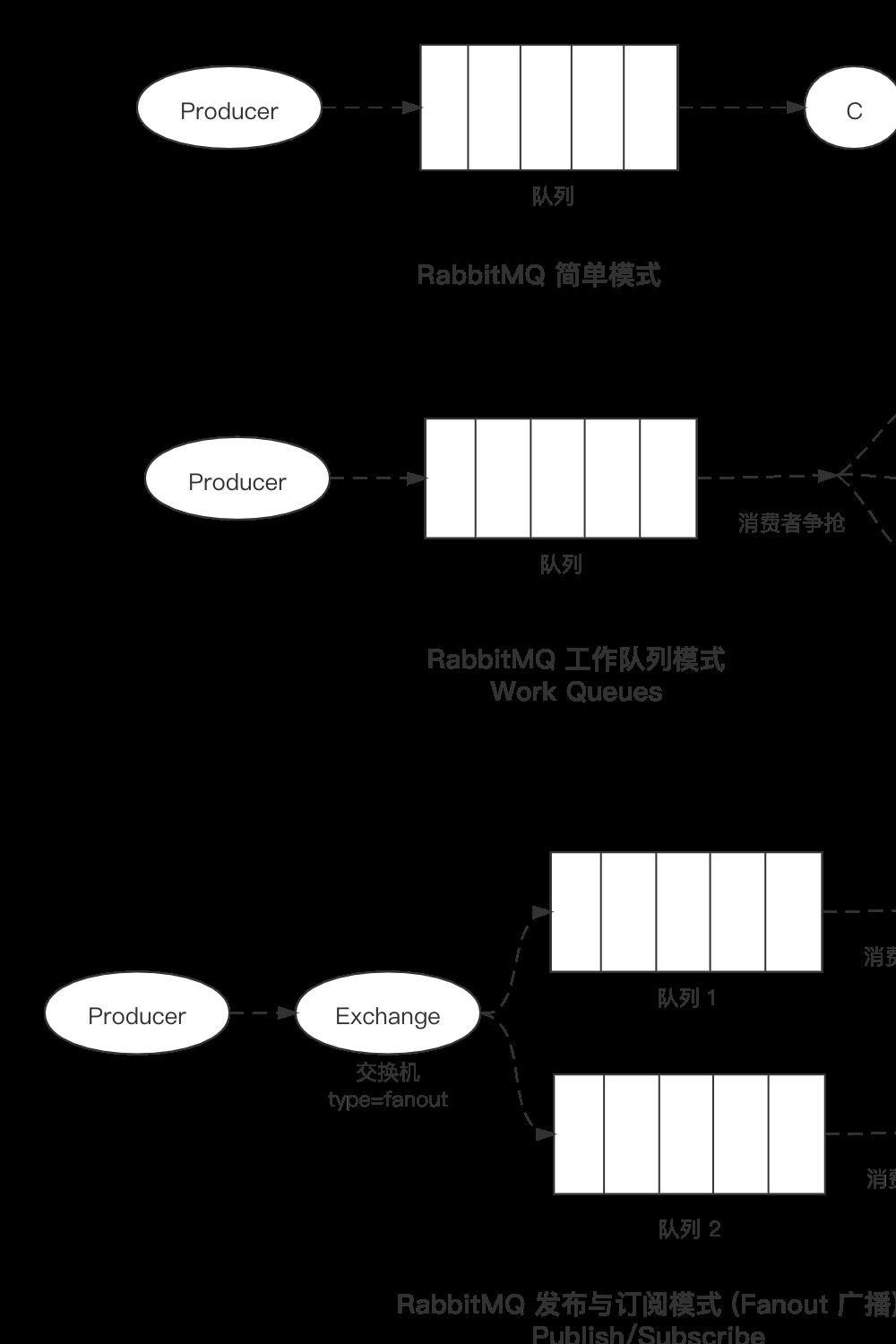
1.1 工程基本信息

1.2 依赖信息
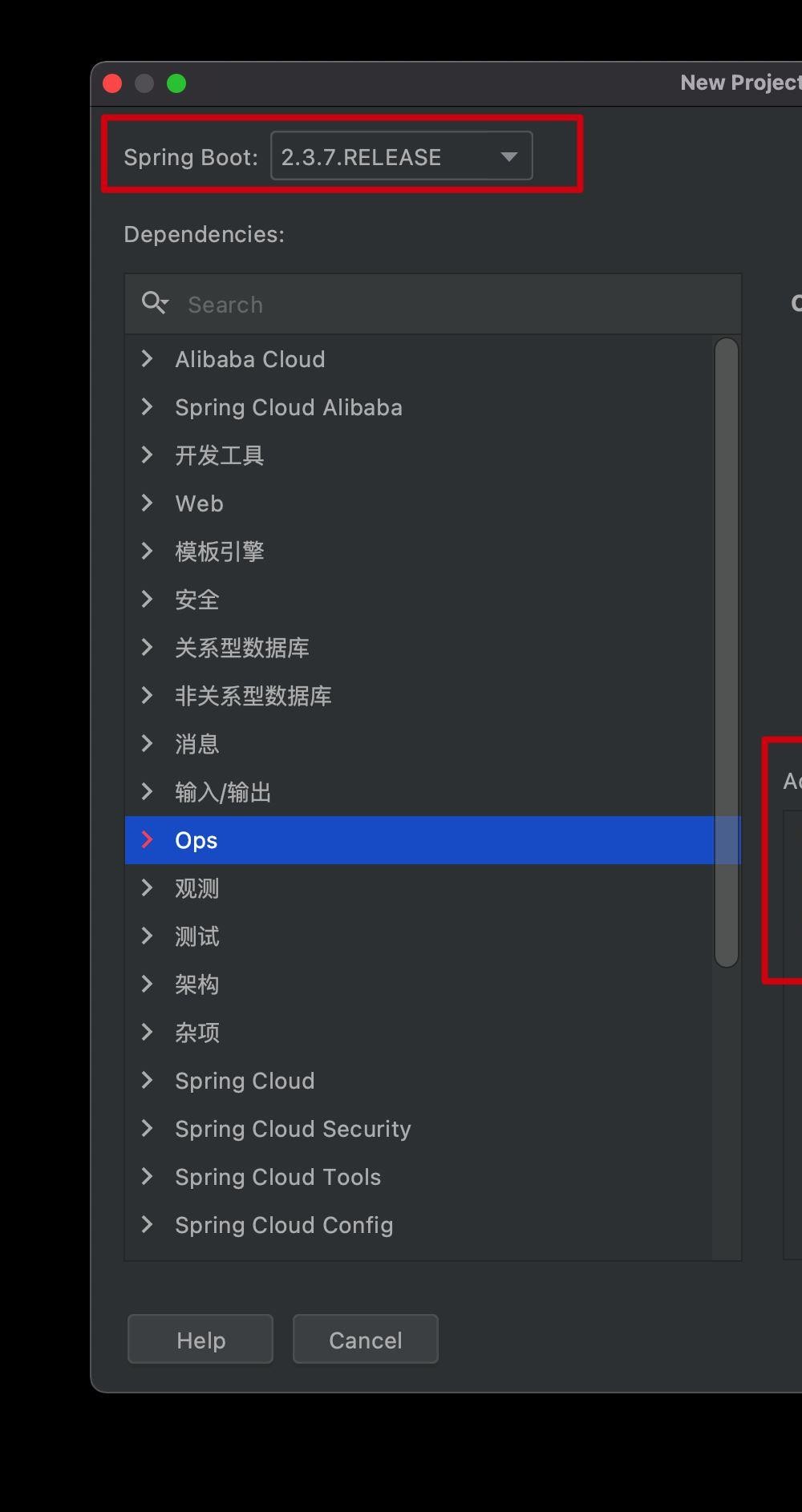
1.3 配置文件applicasion.properties
# 应用名称
spring.application.name=springboot-demo
# Actuator WEB 访问端口
management.server.port=8801
management.endpoints.jmx.exposure.include=*
management.endpoints.web.exposure.include=*
management.endpoint.health.show-details=always
# 应用服务 WEB 访问端口
server.port=8801
######################### RabbitMQ配置 ########################
# RabbitMQ主机
spring.rabbitmq.host=127.0.0.1
# RabbitMQ虚拟主机
spring.rabbitmq.virtual-host=demo
# RabbitMQ服务端口
spring.rabbitmq.port=5672
# RabbitMQ服务用户名
spring.rabbitmq.username=admin
# RabbitMQ服务密码
spring.rabbitmq.passWord=admin
# RabbitMQ服务发布确认属性配置
## NONE值是禁用发布确认模式,是默认值
## CORRELATED值是发布消息成功到交换器后会触发回调方法
## SIMPLE值经测试有两种效果,其一效果和CORRELATED值一样会触发回调方法,其二在发布消息成功后使用rabbitTemplate调用waitForConfirms或waitForConfirmsOrDie方法等待broker节点返回发送结果,根据返回结果来判定下一步的逻辑,要注意的点是waitForConfirmsOrDie方法如果返回false则会关闭channel,则接下来无法发送消息到broker;
spring.rabbitmq.publisher-confirm-type=simple
# RabbitMQ服务开启消息发送确认
spring.rabbitmq.publisher-returns=true
######################### simple模式配置 ########################
# RabbitMQ服务 消息接收确认模式
## NONE:不确认
## AUTO:自动确认
## MANUAL:手动确认
spring.rabbitmq.listener.simple.acknowledge-mode=manual
# 指定最小的消费者数量
spring.rabbitmq.listener.simple.concurrency=1
# 指定最大的消费者数量
spring.rabbitmq.listener.simple.max-concurrency=1
# 开启支持重试
spring.rabbitmq.listener.simple.retry.enabled=true2.1 创建SimpleQueueConfig 简单队列配置类
package com.gmtGo.demo.simple;
import org.springframework.amqp.core.Queue;
import org.springframework.context.annotation.Bean;
import org.springframework.context.annotation.Configuration;
@Configuration
public class SimpleQueueConfig {
private final String simpleQueue = "queue_simple";
@Bean
public Queue simpleQueue() {
return new Queue(simpleQueue);
}
}2.2 编写生产者
package com.gmtgo.demo.simple;
import lombok.extern.slf4j.Slf4j;
import org.springframework.amqp.rabbit.core.RabbitTemplate;
import org.springframework.beans.factory.annotation.Autowired;
import org.springframework.stereotype.Component;
@Slf4j
@Component
public class SimpleProducer {
@Autowired
private RabbitTemplate rabbitTemplate;
public void sendMessage() {
for (int i = 0; i < 5; i++) {
String message = "简单消息" + i;
log.info("我是生产信息:{}", message);
rabbitTemplate.convertAndSend( "queue_simple", message);
}
}
}2.3 编写消费者
package com.gmtgo.demo.simple;
import com.rabbitmq.client.Channel;
import lombok.extern.slf4j.Slf4j;
import org.springframework.amqp.core.Message;
import org.springframework.amqp.rabbit.annotation.RabbitListener;
import org.springframework.stereotype.Component;
import java.io.IOException;
@Slf4j
@Component
public class SimpleConsumers {
@RabbitListener(queues = "queue_simple")
public void readMessage(Message message, Channel channel) throws IOException {
channel.basicAck(message.getMessageProperties().getDeliveryTag(), false);
log.info("我是消费信息:{}", new String(message.getBody()));
}
}2.4 编写访问类
package com.gmtgo.demo.simple;
import org.springframework.beans.factory.annotation.Autowired;
import org.springframework.web.bind.annotation.RequestMapping;
import org.springframework.web.bind.annotation.RestController;
@RestController
@RequestMapping(value = "/rabbitMq")
public class SimpleRabbitMqController {
@Autowired
private SimpleProducer simpleProducer;
@RequestMapping(value = "/simpleQueueTest")
public String simpleQueueTest() {
simpleProducer.sendMessage();
return "success";
}
}2.5 测试启动项目访问 simpleQueueTest
访问地址:Http://127.0.0.1:8801/rabbitMq/simpleQueueTest
结果:

3.1 编写工作配置
package com.gmtgo.demo.work;
import org.springframework.amqp.core.Queue;
import org.springframework.context.annotation.Bean;
import org.springframework.context.annotation.Configuration;
@Configuration
public class WorkQueueConfig {
private final String work = "work_queue";
@Bean
public Queue workQueue() {
return new Queue(work);
}
}3.2 编写生产者
package com.gmtgo.demo.work;
import lombok.extern.slf4j.Slf4j;
import org.springframework.amqp.rabbit.core.RabbitTemplate;
import org.springframework.beans.factory.annotation.Autowired;
import org.springframework.stereotype.Component;
@Slf4j
@Component
public class WorkProducer {
@Autowired
private RabbitTemplate rabbitTemplate;
public void sendMessage() {
for (int i = 0; i < 10; i++) {
String message = "工作消息" + i;
log.info("我是生产信息:{}", message);
rabbitTemplate.convertAndSend("work_queue", message);
}
}
}3.3 编写消费者1
package com.gmtgo.demo.work;
import com.rabbitmq.client.Channel;
import lombok.extern.slf4j.Slf4j;
import org.springframework.amqp.core.Message;
import org.springframework.amqp.rabbit.annotation.RabbitListener;
import org.springframework.stereotype.Component;
import java.io.IOException;
@Slf4j
@Component
public class WorkConsumers1 {
@RabbitListener(queues = "work_queue")
public void readMessage(Message message, Channel channel) throws IOException {
channel.basicAck(message.getMessageProperties().getDeliveryTag(), false);
log.info("我是消费信息1:{}", new String(message.getBody()));
}
}3.4 编写消费者2
package com.gmtgo.demo.work;
import com.rabbitmq.client.Channel;
import lombok.extern.slf4j.Slf4j;
import org.springframework.amqp.core.Message;
import org.springframework.amqp.rabbit.annotation.RabbitListener;
import org.springframework.stereotype.Component;
import java.io.IOException;
@Slf4j
@Component
public class WorkConsumers2 {
@RabbitListener(queues = "work_queue")
public void readMessage(Message message, Channel channel) throws IOException {
channel.basicAck(message.getMessageProperties().getDeliveryTag(), false);
log.info("我是消费信息2:{}", new String(message.getBody()));
}
}3.5 编写测试方法
package com.gmtgo.demo.work;
import org.springframework.beans.factory.annotation.Autowired;
import org.springframework.web.bind.annotation.RequestMapping;
import org.springframework.web.bind.annotation.RestController;
@RestController
@RequestMapping(value = "rabbitMq")
public class WorkRabbitMqController {
@Autowired
private WorkProducer workProducer;
@RequestMapping(value = "workQueueTest")
public String workQueueTest() {
workProducer.sendMessage();
return "success";
}
}
3.6 测试启动项目访问 workQueueTest
访问地址http://127.0.0.1:8801/rabbitMq/workQueueTest
结果:

控制台打印,发现10条消息 偶数条消费者1获取,奇数条消费者2获取,并且平均分配。
当然通过代码实现按需分配,即谁的性能强,谁优先原则,实现负载均衡。
配置可控分配数

订阅模式–多个消费者监听不同的队列,但队列都绑定同一个交换机
4.1 编写订阅配置类
package com.gmtgo.demo.fanout;
import org.springframework.amqp.core.Binding;
import org.springframework.amqp.core.BindingBuilder;
import org.springframework.amqp.core.FanoutExchange;
import org.springframework.amqp.core.Queue;
import org.springframework.context.annotation.Bean;
import org.springframework.context.annotation.Configuration;
@Configuration
public class FanoutQueueConfig {
private final String fanout1 = "fanout_queue_1";
private final String fanout2 = "fanout_queue_2";
private final String fanoutExchange = "fanoutExchange";
@Bean
public Queue fanoutQueue1() {
return new Queue(fanout1);
}
@Bean
public Queue fanoutQueue2() {
return new Queue(fanout2);
}
@Bean
public FanoutExchange exchange() {
return new FanoutExchange(fanoutExchange);
}
@Bean
public Binding bindingFanoutQueue1(Queue fanoutQueue1, FanoutExchange exchange) {
return BindingBuilder.bind(fanoutQueue1).to(exchange);
}
@Bean
public Binding bindingFanoutQueue2(Queue fanoutQueue2, FanoutExchange exchange) {
return BindingBuilder.bind(fanoutQueue2).to(exchange);
}
}4.2 编写订阅生产者
package com.gmtgo.demo.fanout;
import lombok.extern.slf4j.Slf4j;
import org.springframework.amqp.rabbit.core.RabbitTemplate;
import org.springframework.beans.factory.annotation.Autowired;
import org.springframework.stereotype.Component;
@Slf4j
@Component
public class FanoutProducer {
@Autowired
private RabbitTemplate rabbitTemplate;
public void sendMessage() {
for (int i = 0; i < 5; i++) {
String message = "订阅模式消息" + i;
log.info("我是生产信息:{}", message);
rabbitTemplate.convertAndSend("fanoutExchange", "", message);
}
}
}4.3 编写订阅消费者1
package com.gmtgo.demo.fanout;
import com.rabbitmq.client.Channel;
import lombok.extern.slf4j.Slf4j;
import org.springframework.amqp.core.Message;
import org.springframework.amqp.rabbit.annotation.RabbitListener;
import org.springframework.stereotype.Component;
import java.io.IOException;
@Slf4j
@Component
public class FanoutConsumers1 {
@RabbitListener(queues = "fanout_queue_1")
public void readMessage(Message message, Channel channel) throws IOException {
channel.basicAck(message.getMessageProperties().getDeliveryTag(), false);
log.info("我是消费信息1:{}", new String(message.getBody()));
}
}4.4 编写订阅消费者2
package com.gmtgo.demo.fanout;
import com.rabbitmq.client.Channel;
import lombok.extern.slf4j.Slf4j;
import org.springframework.amqp.core.Message;
import org.springframework.amqp.rabbit.annotation.RabbitListener;
import org.springframework.stereotype.Component;
import java.io.IOException;
@Slf4j
@Component
public class FanoutConsumers2 {
@RabbitListener(queues = "fanout_queue_2")
public void readMessage(Message message, Channel channel) throws IOException {
channel.basicAck(message.getMessageProperties().getDeliveryTag(), false);
log.info("我是消费信息2:{}", new String(message.getBody()));
}
}
4.5 编写测试方法
package com.gmtgo.demo.fanout;
import org.springframework.beans.factory.annotation.Autowired;
import org.springframework.web.bind.annotation.RequestMapping;
import org.springframework.web.bind.annotation.RestController;
@RestController
@RequestMapping(value = "rabbitMq")
public class FanoutRabbitMqController {
@Autowired
private FanoutProducer fanoutProducer;
@RequestMapping(value = "fanoutQueueTest")
public String fanoutQueueTest() {
fanoutProducer.sendMessage();
return "success";
}
}3.6 测试启动项目访问 fanoutQueueTest

控制台打印 ,发现两个绑定了不同队列的消费者都接受到了同一条消息查看RabbitMq 服务器:



5.1 编写路由配置类
package com.gmtgo.demo.direct;
import org.springframework.amqp.core.Binding;
import org.springframework.amqp.core.BindingBuilder;
import org.springframework.amqp.core.DirectExchange;
import org.springframework.amqp.core.Queue;
import org.springframework.context.annotation.Bean;
import org.springframework.context.annotation.Configuration;
@Configuration
public class DirectQueueConfig {
private final String direct1 = "direct_queue_1";
private final String direct2 = "direct_queue_2";
private final String directExchange = "directExchange";
@Bean
public Queue directQueue1() {
return new Queue(direct1);
}
@Bean
public Queue directQueue2() {
return new Queue(direct2);
}
@Bean
public DirectExchange directExchange() {
return new DirectExchange(directExchange);
}
@Bean
Binding bindingDirectExchange1(Queue directQueue1, DirectExchange exchange) {
return BindingBuilder.bind(directQueue1).to(exchange).with("update");
}
@Bean
Binding bindingDirectExchange2(Queue directQueue2, DirectExchange exchange) {
return BindingBuilder.bind(directQueue2).to(exchange).with("add");
}
}5.2 编写生产者
package com.gmtgo.demo.direct;
import lombok.extern.slf4j.Slf4j;
import org.springframework.amqp.rabbit.core.RabbitTemplate;
import org.springframework.beans.factory.annotation.Autowired;
import org.springframework.stereotype.Component;
@Slf4j
@Component
public class DirectProducer {
@Autowired
private RabbitTemplate rabbitTemplate;
public void sendMessageA() {
for (int i = 0; i < 5; i++) {
String message = "路由模式--routingKey=update消息" + i;
log.info("我是生产信息:{}", message);
rabbitTemplate.convertAndSend("directExchange", "update", message);
}
}
public void sendMessageB() {
for (int i = 0; i < 5; i++) {
String message = "路由模式--routingKey=add消息" + i;
log.info("我是生产信息:{}", message);
rabbitTemplate.convertAndSend("directExchange", "add", message);
}
}
}5.3 编写消费者1
package com.gmtgo.demo.direct;
import com.rabbitmq.client.Channel;
import lombok.extern.slf4j.Slf4j;
import org.springframework.amqp.core.Message;
import org.springframework.amqp.rabbit.annotation.RabbitListener;
import org.springframework.stereotype.Component;
import java.io.IOException;
@Slf4j
@Component
public class DirectConsumers1 {
@RabbitListener(queues = "direct_queue_1")
public void readMessage(Message message, Channel channel) throws IOException {
channel.basicAck(message.getMessageProperties().getDeliveryTag(), false);
log.info("我是消费信息1:{}", new String(message.getBody()));
}
}5.4 编写消费者2
package com.gmtgo.demo.direct;
import com.rabbitmq.client.Channel;
import lombok.extern.slf4j.Slf4j;
import org.springframework.amqp.core.Message;
import org.springframework.amqp.rabbit.annotation.RabbitListener;
import org.springframework.stereotype.Component;
import java.io.IOException;
@Slf4j
@Component
public class DirectConsumers2 {
@RabbitListener(queues = "direct_queue_2")
public void readMessage(Message message, Channel channel) throws IOException {
channel.basicAck(message.getMessageProperties().getDeliveryTag(), false);
log.info("我是消费信息2:{}", new String(message.getBody()));
}
}5.5 编写访问类
package com.gmtgo.demo.direct;
import org.springframework.beans.factory.annotation.Autowired;
import org.springframework.web.bind.annotation.RequestMapping;
import org.springframework.web.bind.annotation.RestController;
@RestController
@RequestMapping(value = "rabbitMq")
public class DirectRabbitMqController {
@Autowired
private DirectProducer directProducer;
@RequestMapping(value = "directQueueTest1")
public String directQueueTest1() {
directProducer.sendMessageA();
return "success";
}
@RequestMapping(value = "directQueueTest2")
public String directQueueTest2() {
directProducer.sendMessageB();
return "success";
}
}5.6 测试启动项目访问directQueueTest1 , directQueueTest2
访问地址http://127.0.0.1:8801/rabbitMq/directQueueTest1
访问地址http://127.0.0.1:8801/rabbitMq/directQueueTest2
结果:directQueueTest1:

directQueueTest2:
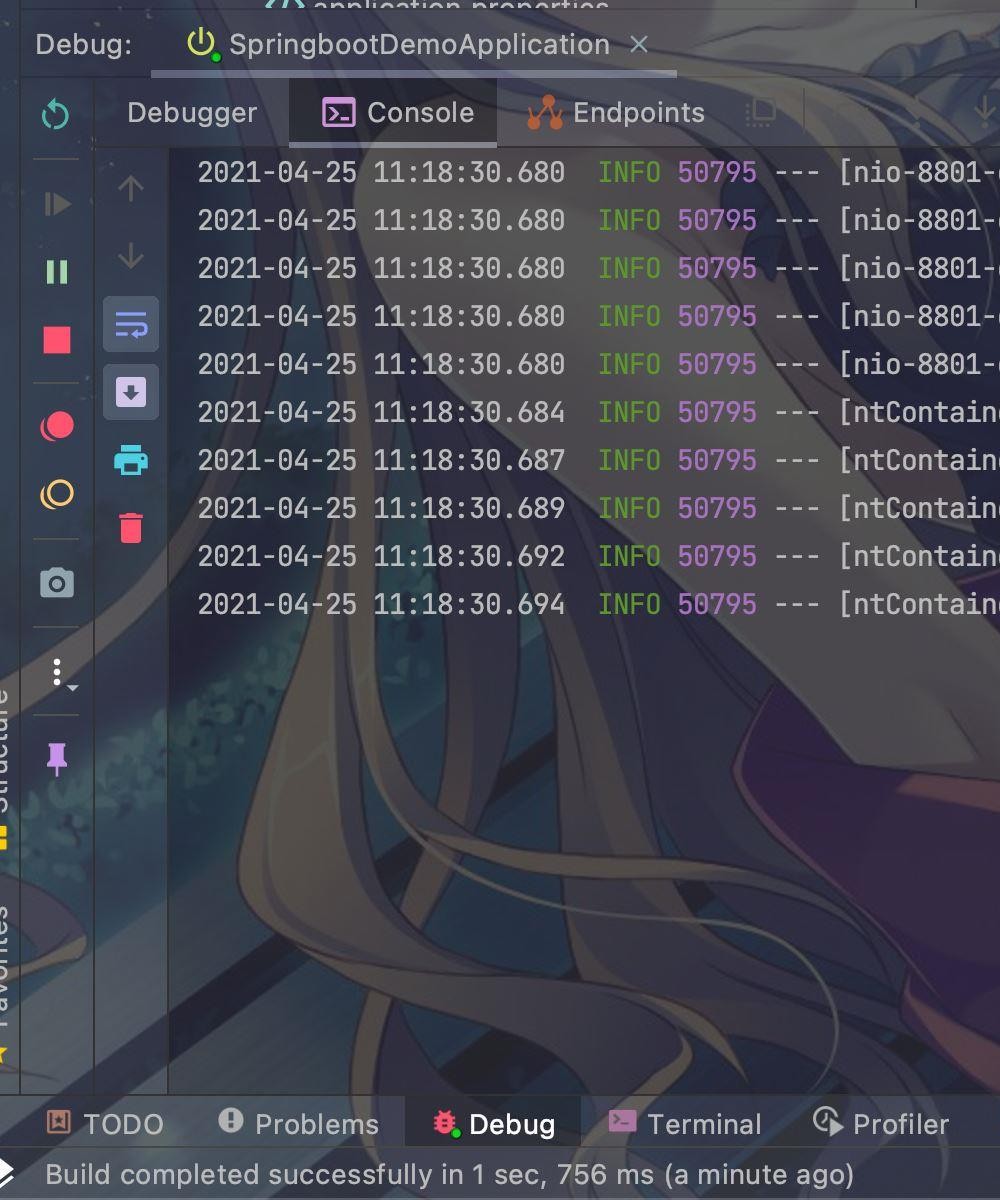
6.1 编写路由配置类
package com.gmtgo.demo.topic;
import org.springframework.amqp.core.*;
import org.springframework.context.annotation.Bean;
import org.springframework.context.annotation.Configuration;
@Configuration
public class TopicQueueConfig {
private final String topic1 = "topic_queue_1";
private final String topic2 = "topic_queue_2";
private final String topicExchange = "topicExchange";
@Bean
public Queue topicQueue1() {
return new Queue(topic1);
}
@Bean
public Queue topicQueue2() {
return new Queue(topic2);
}
@Bean
public TopicExchange topicExchange() {
return new TopicExchange(topicExchange);
}
@Bean
Binding bindingTopicExchange1(Queue topicQueue1, TopicExchange exchange) {
return BindingBuilder.bind(topicQueue1).to(exchange).with("topic.keyA");
}
@Bean
Binding bindingTopicExchange2(Queue topicQueue2, TopicExchange exchange) {
return BindingBuilder.bind(topicQueue2).to(exchange).with("topic.#");
}
}6.2 编写生产者
package com.gmtgo.demo.topic;
import lombok.extern.slf4j.Slf4j;
import org.springframework.amqp.rabbit.core.RabbitTemplate;
import org.springframework.beans.factory.annotation.Autowired;
import org.springframework.stereotype.Component;
@Slf4j
@Component
public class TopicProducer {
@Autowired
private RabbitTemplate rabbitTemplate;
public void sendMessageA() {
for (int i = 0; i < 5; i++) {
String message = "通配符模式--routingKey=topic.keyA消息" + i;
log.info("我是生产信息:{}", message);
rabbitTemplate.convertAndSend("topicExchange", "topic.keyA", message);
}
}
public void sendMessageB() {
for (int i = 0; i < 5; i++) {
String message = "通配符模式--routingKey=topic.#消息" + i;
log.info("我是生产信息:{}", message);
rabbitTemplate.convertAndSend("topicExchange", "topic.keyD.keyE", message);
}
}
}6.3 编写消费者1
package com.gmtgo.demo.topic;
import com.rabbitmq.client.Channel;
import lombok.extern.slf4j.Slf4j;
import org.springframework.amqp.core.Message;
import org.springframework.amqp.rabbit.annotation.RabbitListener;
import org.springframework.stereotype.Component;
import java.io.IOException;
@Slf4j
@Component
public class TopicConsumers1 {
@RabbitListener(queues = "topic_queue_1")
public void readMessage(Message message, Channel channel) throws IOException {
channel.basicAck(message.getMessageProperties().getDeliveryTag(), false);
log.info("我是消费信息1:{}",new String(message.getBody()));
}
}6.4 编写消费者2
package com.gmtgo.demo.topic;
import com.rabbitmq.client.Channel;
import lombok.extern.slf4j.Slf4j;
import org.springframework.amqp.core.Message;
import org.springframework.amqp.rabbit.annotation.RabbitListener;
import org.springframework.stereotype.Component;
import java.io.IOException;
@Slf4j
@Component
public class TopicConsumers2 {
@RabbitListener(queues = "topic_queue_2")
public void readMessage(Message message, Channel channel) throws IOException {
channel.basicAck(message.getMessageProperties().getDeliveryTag(), false);
log.info("我是消费信息2:{}",new String(message.getBody()));
}
}6.5 编写访问类
package com.gmtgo.demo.topic;
import org.springframework.beans.factory.annotation.Autowired;
import org.springframework.web.bind.annotation.RequestMapping;
import org.springframework.web.bind.annotation.RestController;
@RestController
@RequestMapping(value = "rabbitMq")
public class TopicRabbitMqController {
@Autowired
private TopicProducer topicProducer;
@RequestMapping(value = "topicQueueTest1")
public String topicQueueTest1() {
topicProducer.sendMessageA();
return "success";
}
@RequestMapping(value = "topicQueueTest2")
public String topicQueueTest2() {
topicProducer.sendMessageB();
return "success";
}
}6.6 测试启动项目访问topicQueueTest1 , topicQueueTest2
topicQueueTest1,两个消费者都能消费
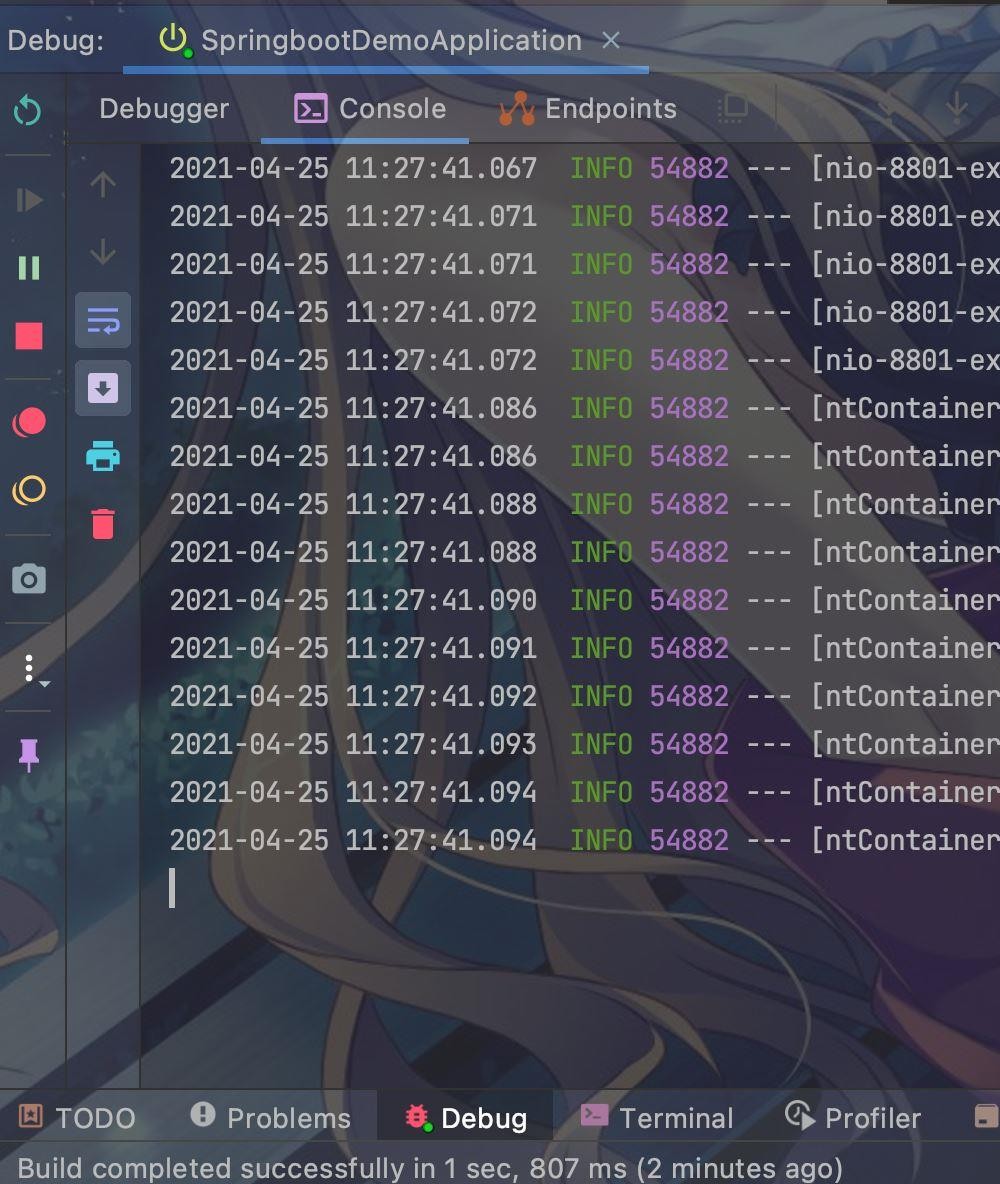
topicQueueTest2,只有消费者2 可以消费

至此,五种队列的实现已结束!
7.1 配置文件
######################### RabbitMQ配置 ########################
# RabbitMQ主机
spring.rabbitmq.host=127.0.0.1
# RabbitMQ虚拟主机
spring.rabbitmq.virtual-host=demo
# RabbitMQ服务端口
spring.rabbitmq.port=5672
# RabbitMQ服务用户名
spring.rabbitmq.username=admin
# RabbitMQ服务密码
spring.rabbitmq.password=admin
# RabbitMQ服务发布确认属性配置
## NONE值是禁用发布确认模式,是默认值
## CORRELATED值是发布消息成功到交换器后会触发回调方法
## SIMPLE值经测试有两种效果,其一效果和CORRELATED值一样会触发回调方法,其二在发布消息成功后使用rabbitTemplate调用waitForConfirms或waitForConfirmsOrDie方法等待broker节点返回发送结果,根据返回结果来判定下一步的逻辑,要注意的点是waitForConfirmsOrDie方法如果返回false则会关闭channel,则接下来无法发送消息到broker;
spring.rabbitmq.publisher-confirm-type=simple
# 连接超时时间
spring.rabbitmq.connection-timeout=20000
# RabbitMQ服务开启消息发送确认
spring.rabbitmq.publisher-returns=true
######################### simple模式配置 ########################
# RabbitMQ服务 消息接收确认模式
## NONE:不确认
## AUTO:自动确认
## MANUAL:手动确认
spring.rabbitmq.listener.simple.acknowledge-mode=manual
# 指定最小的消费者数量
spring.rabbitmq.listener.simple.concurrency=1
# 指定最大的消费者数量
spring.rabbitmq.listener.simple.max-concurrency=1
# 每次只消费一个消息
spring.rabbitmq.listener.simple.prefetch=1
# 开启支持重试
spring.rabbitmq.listener.simple.retry.enabled=true
# 启用强制信息,默认为false
spring.rabbitmq.template.mandatory=true7.2 编写消息发送确认类 RabbitConfirmCallback
package com.gmtgo.demo.config;
import lombok.extern.slf4j.Slf4j;
import org.springframework.amqp.rabbit.connection.CorrelationData;
import org.springframework.amqp.rabbit.core.RabbitTemplate;
@Slf4j
public class RabbitConfirmCallback implements RabbitTemplate.ConfirmCallback {
@Override
public void confirm(CorrelationData correlationData, boolean ack, String cause) {
log.info("=======ConfirmCallback=========");
log.info("correlationData {} " , correlationData);
log.info("ack = {}" , ack);
log.info("cause = {}" , cause);
log.info("=======ConfirmCallback=========");
}
}
7.3 编写消息发送交换机返回机制RabbitConfirmReturnCallBack
package com.gmtgo.demo.config;
import lombok.extern.slf4j.Slf4j;
import org.springframework.amqp.core.Message;
import org.springframework.amqp.rabbit.core.RabbitTemplate;
@Slf4j
public class RabbitConfirmReturnCallBack implements RabbitTemplate.ReturnCallback {
@Override
public void returnedMessage(Message message, int replyCode, String replyText, String exchange, String routingKey) {
log.info("--------------ReturnCallback----------------");
log.info("message = " + message);
log.info("replyCode = {}", replyCode);
log.info("replyText = {}", replyText);
log.info("exchange = {}", exchange);
log.info("routingKey = {}", routingKey);
log.info("--------------ReturnCallback----------------");
}
}
7.4 RabbitMQ配置
在我们的rabbit队列配置类里设置RabbitTemplate
举例:
package com.gmtgo.demo.topic;
import com.gmtgo.demo.config.RabbitConfirmCallback;
import com.gmtgo.demo.config.RabbitConfirmReturnCallBack;
import org.springframework.amqp.core.Binding;
import org.springframework.amqp.core.BindingBuilder;
import org.springframework.amqp.core.Queue;
import org.springframework.amqp.core.TopicExchange;
import org.springframework.amqp.rabbit.core.RabbitTemplate;
import org.springframework.beans.factory.annotation.Autowired;
import org.springframework.context.annotation.Bean;
import org.springframework.context.annotation.Configuration;
import javax.annotation.PostConstruct;
@Configuration
public class TopicQueueConfig {
@Autowired
private RabbitTemplate rabbitTemplate;
@PostConstruct
public void initRabbitTemplate() {
// 设置生产者消息确认
rabbitTemplate.setConfirmCallback(new RabbitConfirmCallback());
rabbitTemplate.setReturnCallback(new RabbitConfirmReturnCallBack());
}
private final String topic1 = "topic_queue_1";
private final String topic2 = "topic_queue_2";
private final String topicExchange = "topicExchange";
@Bean
public Queue topicQueue1() {
return new Queue(topic1);
}
@Bean
public Queue topicQueue2() {
return new Queue(topic2);
}
@Bean
public TopicExchange topicExchange() {
return new TopicExchange(topicExchange);
}
@Bean
Binding bindingTopicExchange1(Queue topicQueue1, TopicExchange exchange) {
return BindingBuilder.bind(topicQueue1).to(exchange).with("topic.keyA");
}
@Bean
Binding bindingTopicExchange2(Queue topicQueue2, TopicExchange exchange) {
return BindingBuilder.bind(topicQueue2).to(exchange).with("topic.#");
}
}启动项目发送消息,消息被正常消费,confim回调返回ack=true如果我们将exchange修改,发送到一个不存在的exchange中,会怎么样呢?
会发现confirm回调为false,打印出结果为不存在topicExchange1111的交换机

如果我们在消费端处理逻辑时出错会怎么样呢?修改消费端代码我们在消费时让它报错

confirm回调为true,但是在rabbitmq的web界面会发现存在5条没有消费的消息

如果我们把
channel.basicNack(message.getMessageProperties().getDeliveryTag(),false,false);中最后一个参数改为false呢,会发现在web管理界面没有未被消费的消息,说明这条消息已经被摒弃。
实际开发中,到底是打回到队列呢还是摒弃,要看自己的需求,但是打回队列应该有次数限制,不然会陷入死循环。
继续测试,将routingKey修改为一个没有的key,
7.5 结论
8. 项目示例代码:
下载地址:springboot-rabbitmq-demo_1619322789961
到此这篇关于rabbitmq五种模式详解(含实现代码)的文章就介绍到这了,更多相关rabbitmq五种模式内容请搜索编程网以前的文章或继续浏览下面的相关文章希望大家以后多多支持编程网!
--结束END--
本文标题: rabbitmq五种模式详解(含实现代码)
本文链接: https://lsjlt.com/news/124585.html(转载时请注明来源链接)
有问题或投稿请发送至: 邮箱/279061341@qq.com QQ/279061341
2024-03-01
2024-03-01
2024-03-01
2024-02-29
2024-02-29
2024-02-29
2024-02-29
2024-02-29
2024-02-29
2024-02-29
回答
回答
回答
回答
回答
回答
回答
回答
回答
回答
0